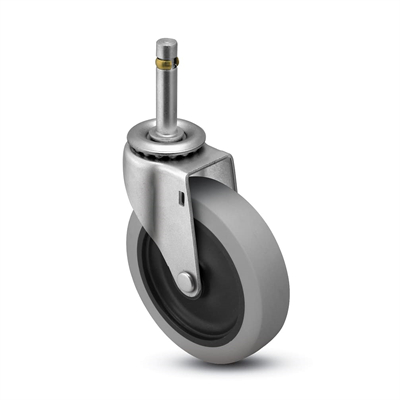Rigid casters are a specific type of caster that does not swivel, and they are designed for straight-line motion. They are a great choice in certain situations where stability and control are more important than maneuverability. Here are some scenarios in which you might choose rigid casters:
- Straight-Line Movement: When your primary requirement is to move an object or equipment in a straight line without deviation, rigid casters are the ideal choice. They are excellent for maintaining a consistent path and preventing accidental changes in direction.
- Stability: Rigid casters are chosen when stability is a top priority. They excel at providing a stable and secure base for your equipment. This is especially important when dealing with heavy loads or delicate instruments that need to remain steady during transport.
- Heavy Loads: Rigid casters are often used in applications where heavy loads need to be moved. They are better at handling higher weight capacities compared to swivel casters, as they don’t have the swiveling mechanism, which can be a point of weakness.
- Reduced Maintenance: Rigid casters typically require less maintenance than swivel casters because they have fewer moving parts. This makes them a cost-effective choice in scenarios where minimal upkeep is desired.
- Precision Control: If you need precise control over the direction of movement, rigid casters are the right choice. They allow for accurate positioning and controlled movement, which is crucial in applications like manufacturing, robotics, or industrial machinery.
- Cost-Effective Solutions: Rigid casters are generally more affordable than swivel casters, and they can provide a cost-effective solution in applications where maneuverability is not a primary concern.
- Reduced Noise and Vibration: Rigid casters tend to produce less noise and vibration compared to swivel casters. This makes them suitable for applications where a quieter or vibration-free environment is required, such as in healthcare settings.
- Maintaining Alignment: In situations where it’s critical to maintain a fixed alignment or orientation, rigid casters are the better choice. They prevent lateral movement and ensure that the equipment or object stays in a specified direction.
- Preventing Unwanted Movement: In some cases, unwanted swiveling or pivoting can be hazardous or disruptive. Rigid casters eliminate this risk by staying in a fixed position.
It’s important to note that rigid casters are not suitable for applications that require frequent changes in direction or tight maneuverability, as they can’t swivel. In such cases, a combination of rigid and swivel casters may be used to achieve the desired balance between stability and maneuverability. When choosing casters, consider the specific requirements of your application, load capacity, and the environment in which they will be used to determine whether rigid casters are the right choice.


